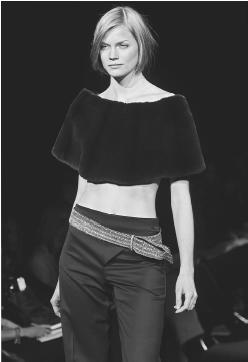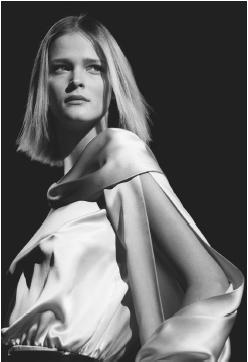Carolina Herrera - Fashion Designer Encyclopedia
Venezuelan designer working in New York
Born: Maria Carolina Josefina Pacanins y Nino in Caracas, Venezuela, 8 January 1939. Education: El Carmen School, Venezuela. Family: Married Reinaldo Herrera, 1957; children: Mercedes, Ana Luisa, Carolina, Patricia. Career: Showed first couture collection, 1981; introduced fur collection for Revillion, 1984; launched CH diffusion line, 1986, Couture Bridal collection, 1987, Carolina Herrera Collection II sportswear line, 1989, Herrera for Men, Herrera Studio bridge line, and W by Carolina Herrera, 1992; introduced Carolina Herrera fragrances, 1988; introduced jewelry collections, 1990, 1991; moved toward more youthful styles influenced by her daughters, late 1990s; signed deal with STL of Spain for men's and women's gold-range apparel and retail stores in Europe, 2000; opened first free-standing boutique on Madison Avenue in New York, 2000. Awards: Pratt Institute award, 1990; Dallas Fashion Excellence award. Address: 48 West 38th Street, New York, NY 10018, USA.
Publications
On HERRERA:
Books
Diamonstein, Barbaralee, Fashion: The Inside Story, New York,1985.
Steele, Valerie, Women of Fashion: Twentieth-Century Designers, New York, 1991.
Riehecky, Janet, Carolina Hererra: International Fahsion Designer, Chicago, 1991.
Navarette Talavera, Ela, Perfiles latinoamericanos de los 1990s, Panama, 1992.
Stegemeyer, Anne, Who's Who in Fashion, Third Edition, New York,1996.
Telgen, Diane, and Jim Kamp, Latinas! Women of Achievement, Detroit, 1996.
Morey, Janet, and Wendy Dunn, Famous Hispanic Americans, NewYork, 1996.

Articles
Shapiro, Harriet, "From Venezuela to Seventh Avenue, Carolina Herrera's Fashions Cast a Long Shadow," in People, 3 May 1982.
Rayner, William, and Chesbrough Rayner, "An Evening with Carolina and Reinaldo Herrera: Strong Opinions, European Style," in Vogue, March 1987.
Daria, Irene, "Carolina Herrera: A Personal Evolution," in WWD, 2March 1987.
——, "Designers on Designing: Carolina Herrera," in WWD, 2March 1987.
Estrada, Mary Batts, "Carolina Herrera Talks About Fashion," in Hispanic, March 1989.
Reed, Julia, "Talking Fashion: Carolina Herrera is the Undisputed Queen of Seventh Avenue," in Vogue, June 1990.
Koski, Lorna, "Carolina's Prime Time," in WWD, 18 June 1991.
Struensee, Chuck, "Carolina Herrera's New Horizons," in WWD, 20October 1992.
"New York: Carolina Herrera," in WWD, 1 November 1994.
"New York: Carolina Herrera," in WWD, 4 April 1995.
"Carolina Herrera," in Current Biography Yearbook, 1996.
Schiro, Anne Marie, "Designers Who Know Their Customer," in the New York Times, 10 April 1997.
Tapert, Annette, "Women of Style: Carolina Herrera," Town & Country, September 1997.
Horyn, Cathy, "And Now, a Gentle Nudge from Herrera and de laRenta," in the New York Times, 15 September 1999.
Wilson, Eric, "Herrera Mines for Spanish Gold," in WWD, 23 March 2000.
Givhan, Robin, "The Lady Flourishes: Herrera's Work Blossoms with Understated Femininity," in the Washington Post, 8 December 2000.
"WWD Luxury" Special Supplement, in WWD, February 2001.
***
When Carolina Herrera introduced her first fashion collection in 1981, Women's Wear Daily dubbed her "Our Lady of the Sleeve." Her early interest in the shoulder area has remained constant throughout her many lines and seasons. The Herrera look is characterized by strong fitted shoulders, tight bodices, straight lines, and slightly pushed-up sleeves.
Though she has often been referred to as a socialite turned designer, her contributions to the industry are many. Prior to beginning her career as a designer, Herrera was on the International Best Dressed List for over 10 years and was then nominated to the Best Dressed Hall of Fame. Her personal style influenced how women dressed around the world. Her affluent, South American background exposed her to the work of the best couturiers and dressmakers in the world; she cites Balenciaga as her greatest influence. It was a natural transition from socialite to fashion designer, as Herrera is a member of the world for which she designs. She understands her customers' lifestyles and needs because she is one of them. Her friends, impressed with her design quality, fabric selection, attention to detail, construction and drape, soon became her clients.
Herrera's designs have been described as being for the "quintessential woman of the 1980s who has consummate style and taste as well as an active lifestyle." Her clothes have a couture element, feminine detail, and genuine ease. Herrera herself believes her clothes are feminine, elegant, and most important, comfortable. Though she loves to mix and match expensive Italian and French fabrics, she maintains the importance of the cut of the clothes. Herrera states, "You don't have to buy very expensive materials if the clothes are well cut." In terms of color, Herrera favors the combination of black and white or black and brown.
Becoming a designer seemed a logical evolution in Herrera's life. She was married, had four children, and came to symbolize the upper-class South American lifestyle. When her children were grown she decided, with the financial backing of a wealthy South American publisher, to open a design house in New York.
Like many designers, Herrera expanded her business to include other lines. The CH Collections, introduced in 1986, are less expensive versions of her high-fashion lines, similar silhouettes in cut and finish but made of different fabrics. Herrera also launched a successful bridal line in 1987 after designing Caroline Kennedy's wedding gown. A perfume for both women (1988) and men (1991) also followed.
In the early collections, Herrera's strengths were in her day dresses and luncheon suits. They expressed femininity through their beautifully tailored hourglass design. In more recent collections, she has ventured into the downtown New York scene for inspiration, showing chiffon split skirts topped with satin motorcycle jackets, thus illustrating her ability to interpret and combine the surrounding culture with her own design sense. Most important, her clothes are about style and

Herrera has continued to design for women like herself who are wealthy and sophisticated. As Anne-Marie Schiro pointed out in the New York Times, Herrera's customers desire tasteful, flattering clothing, fashionable yet not cutting-edge, incorporating a few surprises yet wearable. Her fall/winter 1997 collection offered some challenges in the form of snakeskin print and black glossy leathers, leopard pattern chiffons, and tiger print velvets. All of these, according to Schiro, were fashioned into the sorts of jackets, coats, and shifts that feel comfortable to Herrera's customers.
Cathy Horyn, also writing in the New York Times, compared Herrera's spring/summer 2000 collection to the designer's personality: both practical and lavish. Most ensembles were comprised of basic pants and a top, but the pants were made of materials such as shantung and the tops of fabrics such as peony-pink fitted suede. A new wrinkle were younger, sexier designs than Herrera had shown in the past, including a lemon-colored bikini and a ball gown with a skirt starting two inches below the waist.
Robin Givhan in the Washington Post also noted Herrera's skew toward the youthful at the end of the millennium, pointing out that the transformation earned her new customers, such as young Hollywood actresses, as well as a wider distribution in specialty stores. Her two daughters, a filmmaker and a fashion editor, were cited as influences. They encouraged her, for example, to create more mix-and-match pieces rather than full ensembles. At the same time, Herrera has kept her traditional customers in mind, moving toward more youthful styles but not shocking them or turning them away. Givhan called Herrera's spring 2000 collection an example of well-groomed, genteel femininity.
In 2000 Herrera signed a licensing agreement with the Spanish apparel company STL to develop a women's and men's gold-range line called CH Carolina Herrera. The deal was expected to lead to the establishment of 40 stores throughout Europe—where her signature and 212 perfume lines have a high profile—within a few years. Herrera had experimented with two bridge lines in the mid-1990s, both of which were discontinued quickly. The new CH line is priced about a third lower than her signature apparel and includes women's sportswear for day and evening as well as men's tailored clothing and sportswear. The deal marked Herrera's first foray into men's apparel, although she had previously produced accessories and scents for men.
The deal paved the way for stores in the U.S.; Herrera opened her first freestanding boutique on New York's Madison Avenue in 2000. In the past, her signature line had been available in only about 100 stores worldwide.
—Margo Seaman;
updated by Karen Raugust
Comment about this article, ask questions, or add new information about this topic: